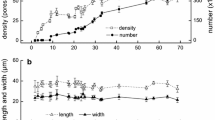Abstract
The mutual relationship between the water potential and water saturation deficit (w.s.d.) was studied on samples of leaf tissue of fodder cabage. Definite values of water potential were obtained by long-term exposure of plant material to an atmosphere with definite constant pressure of water vapour. The resulting w.s.d. values were determined gravimetrically.
Water saturation deficit varies indirectly with the water potential. This dependence was linear for values of water potential from −4·4 to −43·9 atm.
Since the stabilization of equilibrum of water potential between the leaf tissue and surrounding atmosphere was very slow the relationship between water potential and w.s.d. was influenced by the size of samples and by the length of exposure. Therefore this method was more suitable for relative than for absolute measurement.
Abstract
Ve vzorcích listového pletiva krmné kapusty byla sledována vzájemná závislost vodního potenciálu a vodního sytostního deficitu. Hodnoty vodního potenciálu byly navozeny dlouhou exposicí materiálu v atmosféře s určitou konstantní tensí vodní páry a odpovídající hodnoty v.s.d. byly stanoveny gravimetricky.
Vodní sytostní deficit je nepřímo úměrný vodnímu potenciálu. Pro hodnoty vodního potenciálu −4,4 až −43,9 atm byla jejich závislost lineární.
Poněvadž ustavování rovnováhy vodního potenciálu mezi listovým pletivem a okolním vzduchem bylo velmi pomalé, byla závislost vodního potenciálu a v.s.d. ovlivněna velikostí sledovaného vzorku a délkou exposice. Tato metoda je tedy vhodná spíše k relativním než k absolutním měřením.
Abstract
Иееледовалась взаимная завис имость водного потенциала и водного дефицита в образцах ткани листьев кормовой капусты. Необходимый водный потенциал ткани получали длительной экспозицией материала в атмосфере с постоянным давлением водного пара и соответствующий водный дефицит определяли гравиметрически.
Водный дефицит был обратно пронорциональным водному потенциалу. В границах от −4,4 атм до −43,9 их зависимость была линейной.
Так как устанавливание равновесия водного потенциала между тканью листа и окружающим воздухом происходило очень медленно, на зависимость водного потенциала и водного дефицита влияли размеры исследованных образцов и продолжительность экспозиции. Вследствии этого данный метод более подходит к относительным чем к абсолютным измерениям.
Similar content being viewed by others
References
Barrs, H. D., Slatyer, R. O.: Experience with three vapour methods for measuring water potential in plants.—Arid Zone Res.25: 369–384, 1965.
Box, J. E.: Measurement of water stress in plant leaf discs (Gossypium hirsutum var. Western Stormproof) with a thermocouple psychrometer.—Agron. J.57: 367–370, 1965.
Ehlig, C. F.: Measurement of energy status of water with thermocouple psychrometer.—Plant Physiol.37: 288–290, 1962.
Ehlig, C. F.: Water retention characteristics: plant leaves.—In:Altman, D. L., Dittmer, D. S., (ed.): Environmental Biology p. 463.—Fed. Amer. Soc. Exp. Biol., Bethesda, Maryland, 1966.
Ehlig, C. F., Gardner, W. R.: Relationship between transpiration and the internal water relations of plants.—Agron. J.56: 127–130, 1964.
Gardner, W. R., Ehlig, C. F.: Physical aspects of internal water relations of plant leaves.— Plant. Physiol.40: 705–710, 1965.
Jarvis, P. G., Jarvis, M. S.: The water relations of three seedlings. V. Growth and root respiration in relation to osmotic potential of the root medium.—In:Slavík, B., (ed.): Water Stress in Plants, Academia, Praha pp. 167–182, 1965.
Kreeb, K.: Über die gravimetrische Methode zur Bestimmung der Saugspannung und das Problem des negativen Turgors. I. Mitteilung.—Planta55: 274–282, 1960.
Kreeb, K., Önal, M.: Über die gravimetrische Methode zur Bestimmung der Saugspannung und das negativen Turgors. II. Mitteilung: Die Berücksichtigung von Atmungsverlusten während der Messungen.—Planta56: 409–415, 1961.
Slatyer, R. O.: The measurement of diffusion pressure deficit in plants by a method of vapour equilibration.—Austr. J. biol. Sci.11: 349–365, 1958.
Slatyer, R. O.: Aspects of the tissue relationships of an important arid zone species (Acacia aneura F. Muell.) in comparison with two mesophytes.—Bull. Res. Counc. Israel8D: 159–168, 1960.
Weatherley, P. E., Slatyer, R. O.: Relationship between relative turgidity and diffusion pressure deficit in leaves.—Nature179: 1085–1086, 1957.
Whiteman, P. G., Wilson, G. L.: Estimation of diffusion pressure deficit by correlation with relative turgidity and beta-radiation absorption.—Austr. J. biol. Sci.16: 140–146, 1963.
Author information
Authors and Affiliations
Additional information
Address: Flemingovo nám. 2, Praha 6, Czechoslovakia.
Rights and permissions
About this article
Cite this article
Pospíšilová, J. Determination of relationships between water potential and water saturation deficit in leaf tissue. Biol Plant 11, 202–207 (1969). https://doi.org/10.1007/BF02920798
Received:
Issue Date:
DOI: https://doi.org/10.1007/BF02920798




